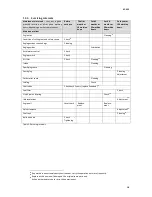
KC-435
11
1.4.1.5
Mounting and adjustment of the harness
For safety and comfort of the operator it is very important to
properly adjust the harness for the particular figure, so that it is
possible to operate the brush cutter/trimmer with the highest
possible comfort and the hanging brush cutter/trimmer is
properly balanced.
The brush cutter/trimmer is delivered with a comfortable harness
(21) for both shoulders.
Put on the harness and secure it with the buckle (22).
Adjust the length of each strap using the tightening buckles (23).
1.4.2
Preparation before use
1.4.2.1
Balancing the machine
Put on the harness in such a way that the quick-clamping clasp is
on your right hip.
Hang the brush cutter/trimmer on one of the four openings on the
anti-vibration element (1) using the snap-hook. Change the
openings until the brush cutter/trimmer is balanced.
Grasp the brush cutter/trimmer in such a way that the cutting tool
is parallel to the ground when holding the machine with both hands.
The optimal position is reached when just imperceptible effort of
the hands is needed to lift the cutting tool above the ground.
If the cutting tool is falling to the ground, it is necessary to move
the snap-hook for one opening forward. On the contrary if the
cutting tool tends to go up, it is necessary to move the snap-
hook for one opening backwards.
It is necessary to check the machine balance when the cutting
tool is mounted and the fuel tank is half-full.
1.4.2.2
Adding the fuel
Use unleaded or low-leaded petrol commonly used for motor vehicles – min. octane number 91. It is
recommended to use the petrol marked BA-95 as it is the most used and most often available petrol.
The unleaded fuel reduces the quantity of the sediments in the combustion chamber. If the fuel level is
low, refuel. Don’t overfill the tank.
Never use petrol mixed with oil, dirty or contaminated. Avoid dirts, dust and water getting into the fuel
tank.
If the machine shall be stored for more than 3 weeks, drain the remaining fuel from the tank and
remove the petrol from the carburettor – the fuel goes stale.
!
The pressure inside the fuel tank naturally rises with the rising temperature of the surroundings. Be
careful when opening the fuel tank, so that the fuel doesn’t squirt out. The petrol can should be stored
in a cold place and it can’t get in touch with direct sunshine in any case.
!
The petrol is very easily ignitable and explosive.
!
Refuel in a well-ventilated space and when the engine is turned off. Don’t smoke and avoid access with
open fire during refuelling and at places where the fuel is placed.
!
Don’t overfill the tank (don’t fill it up to the tank edge) and close the tank when the refuelling is
finished, so that the tank cap is well fastened.
!
Pay attention not to spill any petrol. The petrol fumes as well as the spilled petrol can ignite. If the
petrol is spilled, it is unconditionally necessary to dry up the surroundings and let the petrol fumes
disperse.
!
Avoid repeated and/or longer contact with skin as well as inhalation of the fumes. Store petrol in
sufficient distance from children.
Stop the engine before each refuelling and clean surroundings of the fuel tank neck.
Use a suitable funnel for pouring the fuel, or use a can with a suitable pouring neck.








































